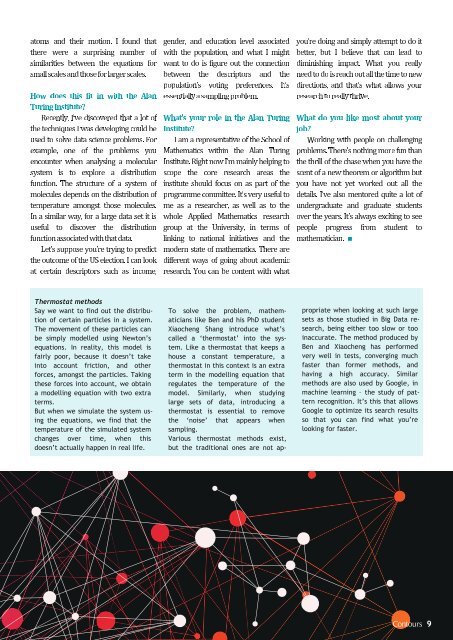Contours 2016-17
Stories from the School of Mathematics. Undergraduate students interview researchers to find out what the life of a mathematician is like.
Stories from the School of Mathematics. Undergraduate students interview researchers to find out what the life of a mathematician is like.
You also want an ePaper? Increase the reach of your titles
YUMPU automatically turns print PDFs into web optimized ePapers that Google loves.
■<br />
Thermostat methods<br />
Say we want to find out the distribution<br />
of certain particles in a system.<br />
The movement of these particles can<br />
be simply modelled using Newton’s<br />
equations. In reality, this model is<br />
fairly poor, because it doesn’t take<br />
into account friction, and other<br />
forces, amongst the particles. Taking<br />
these forces into account, we obtain<br />
a modelling equation with two extra<br />
terms.<br />
But when we simulate the system using<br />
the equations, we find that the<br />
temperature of the simulated system<br />
changes over time, when this<br />
doesn’t actually happen in real life.<br />
To solve the problem, mathematicians<br />
like Ben and his PhD student<br />
Xiaocheng Shang introduce what’s<br />
called a ‘thermostat’ into the system.<br />
Like a thermostat that keeps a<br />
house a constant temperature, a<br />
thermostat in this context is an extra<br />
term in the modelling equation that<br />
regulates the temperature of the<br />
model. Similarly, when studying<br />
large sets of data, introducing a<br />
thermostat is essential to remove<br />
the ‘noise’ that appears when<br />
sampling.<br />
Various thermostat methods exist,<br />
but the traditional ones are not appropriate<br />
when looking at such large<br />
sets as those studied in Big Data research,<br />
being either too slow or too<br />
inaccurate. The method produced by<br />
Ben and Xiaocheng has performed<br />
very well in tests, converging much<br />
faster than former methods, and<br />
having a high accuracy. Similar<br />
methods are also used by Google, in<br />
machine learning – the study of pattern<br />
recognition. It’s this that allows<br />
Google to optimize its search results<br />
so that you can find what you’re<br />
looking for faster.<br />
►<br />
<strong>Contours</strong><br />
9





